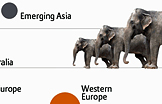Despite the effects of the current financial crisis by 2020 the global retirement market is expected to grow by 66 percent, representing an annual growth rate of 4.7 percent, according to the recent Allianz Demographic Pulse. Total pension assets will increase from 22 trillion euros, to 36 trillion euros. Renate Finke, Senior Pension Analyst at Allianz says: "We expect the escalation in retirement savings to be the driving force for the development of the monetary wealth in many countries in Europe, Asia-Pacific and the United States."
Growth spurt despite crisis: Global retirement assets expected to accumulate 36 trillion euros until 2020
Downloads

Great disparity of assets
Covering slightly more than half of the world's total retirement assets of some 22 trillion euros, in 2009 the United States was the leading retirement market in the world, followed at 11.5 percent by the United Kingdom. Western Europe's combined retirement assets came to slightly more than 20 percent while Australia and Japan each laid claim to 3 percent of the global market. The emerging economies of Asia and central and eastern European (CEE), which are still in the early stages of building up their individual funded pension systems, represented currently only minor shares (1.8 percent and 0.4 percent, respectively).
Emerging countries on the growth path
"The emerging markets of Asia will develop most dynamically", says Renate Finke. "By 2020, these markets are expected to grow by 16.8 percent a year, reaching a total volume of 2.2 euros trillion or the size of United Kingdom's current market." Similar dynamics are expected in central and eastern European economies, where most countries have established a mandatory funded pension pillar over the last decade. Central and Eastern Europe are anticipated to realize an annual growth rate of 15.5 percent until 2020.
Due to their market size and maturity, the larger pension markets are not expected to realize such high growth rates. The U.S. retirement market is still expected to dominate the world pension market until the end of the decade even though it is only expected to grow by a 3.6 percent compound annual growth rate (CAGR). Despite its low growth, the net increase in the United States during this period will equal the total volume of continental western Europe today.

Significant decrease due to financial crisis
The financial and economic crisis has had a significant impact on the volume of global pension assets. At year-end 2008, this volume stood at 20 trillion euros; down by roughly 15 percent from year-end 2007 (23.2 trillion euros). With a steep drop of 22 percent, the largest pension market in the world the United States – was hit even harder. In general, the overall effect of the current financial crisis on pension assets varies in proportion to their equity exposure. The strong rebound in equity markets in 2009 helped pension assets to recover, however, they did not yet reach 2007 levels.
In order to recoup these losses, private households will have no other option than to start to save more for their retirement. This will not only occur in countries with mature funded pension systems, such as the United States, the United Kingdom, the Netherlands and Switzerland. It will also take place in states where reforms of pay-as-you-go systems will lead to lower pension levels that need to be compensated for by a build up of capital to preserve an adequate standard of living. The same holds true for eastern European states and emerging Asia, whose households have just started to save and build up wealth in keeping with their increasing prosperity.
Sustainable pension systems require strong funded pillar
Despite of the great disparity of situations and assets in the global retirement markets challenges are very similar: Ageing societies and rising government debt imply a stronger role for funded pensions. There seems to be an emerging consensus that the best-practice for pension systems worldwide is to combine a sustainable public pillar with a strongly funded pension pillar in order to spread risks.
These fundamental, long-term trends are likely to have a great impact on the future retirement income mix. Finke: "It will be necessary for future retirees to diversify sources of retirement income." The challenge for an individual will be to plan and create the entire mix of retirement income from various sources. "Financial services providers who quickly identify these new customer needs and besides pure capital management offer holistic advisory concepts and additional assistance services will certainly benefit most from the future rise of the global retirement assets."
As with all content published on this site, these statements are subject to our Forward Looking Statement disclaimer.
Link to the disclaimer